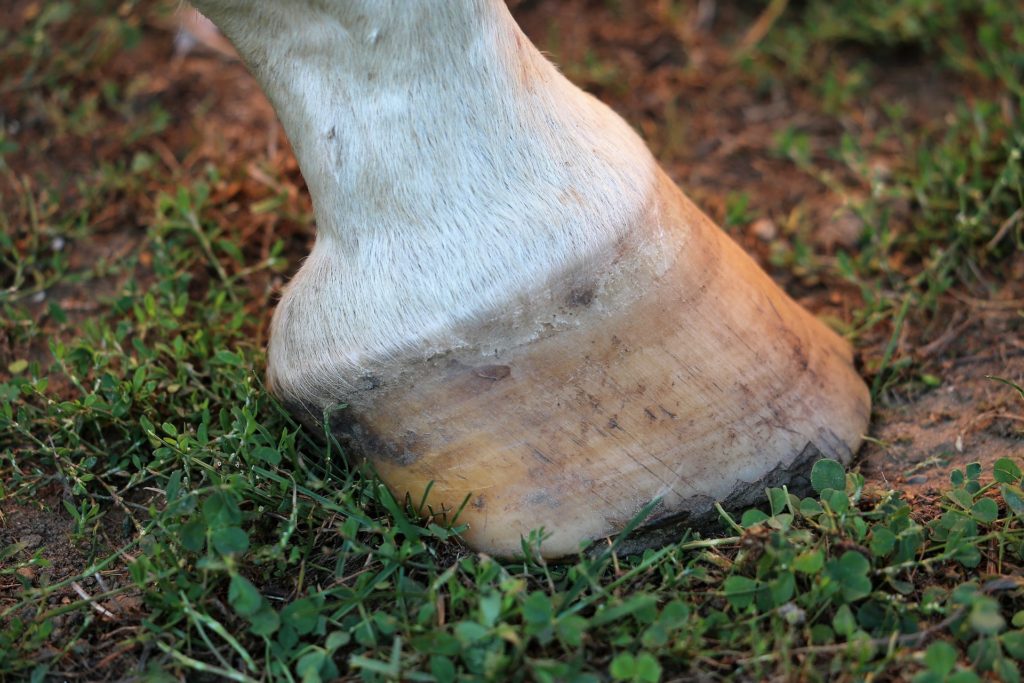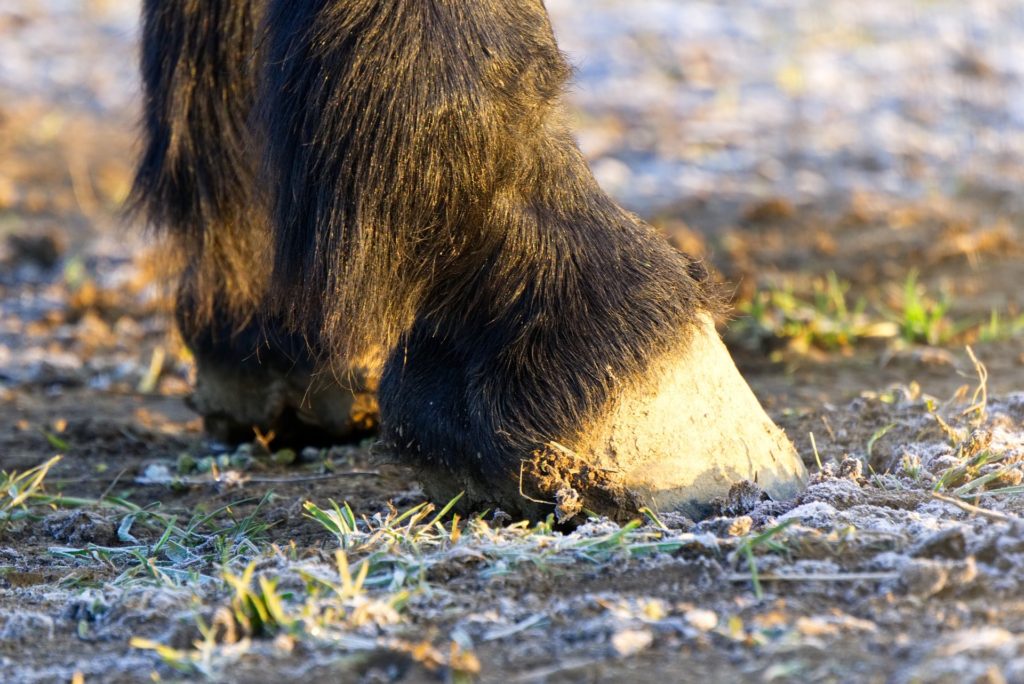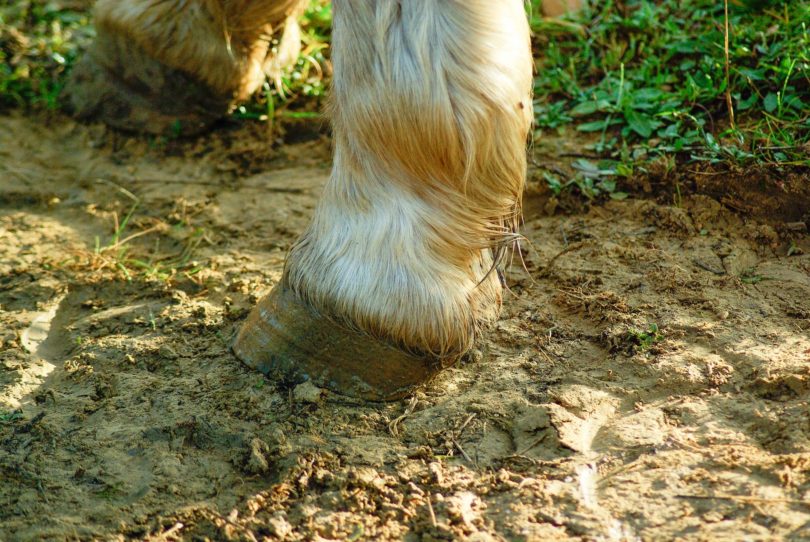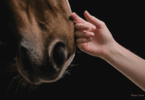Getting to the Bottom of a Common Problem
Thrush is a prevalent occurrence in the equine world. If you haven’t encountered it yet in your time riding, chances are that you will fairly soon (unless, you know, you live in the Sahara Desert).
Thrush in horses is a disease based in moisture and bacteria. It attacks one of the horse’s most vital body parts: the hooves. Pungent odor and tissue-eating behavior make Thrush relatively easy to diagnose, and a black discharge on the underside of the hoof is also common. Ranging in severity, you may catch Thrush while it’s still in the superficial state — or it may progress to the point of lameness and/or abscess. Luckily, there are ways to prevent and treat it!

Source: Pixabay
Growing up riding in Southern California, you would think that I didn’t see much thrush in my lesson horses. San Diego is basically a desert that meets up with the ocean. Even at the barns located farther inland where the dirt was hard-packed, every winter brought thrush. Why?
Because as a drier climate, paddocks weren’t very prepared for rain drainage. So once the rains came, huge mud puddles formed in all the stalls. I’d go to pick my lesson horse’s first hoof and be greeted with an in-your-face half diaper/half stinky sock kind of smell.
In Washington State, we see a lot more rain and endure longer seasons of moisture. A lot of our paddocks, however, are better equipped for drainage. Still, I will occasionally see thrush pop up here and there, and I know how to spot it quickly based on that same ostentatious odor.
 What is Thrush in horses?
What is Thrush in horses?
Thrush is presumed to be a bacteria-based infection because of its pungent odor and its tissue-eating behavior in the hoof. The root cause is essentially moisture left in the hoof for too long. It centers around the frog and the tissue lining around it. Thrush comes with a pungent, black discharge that causes the frog and the surrounding hoof tissue to become soft and break down. You’ll find that the affected hoof tissue will be easy to remove with a hoof pick, and may reveal more black discharge.
While it starts superficially, the infection can penetrate deeper into the hoof and the sensitive area of the frog if left unchecked. If it progresses to this point, it can cause a really painful, sore lameness not unlike an abscessed hoof.

Source: Pixabay
How to Prevent Thrush
Since thrush is caused by moisture left sitting too long in the horse’s hoof, the first step is to create a dry environment for your horse to stand in.
While some climates are harder than others, you can either provide a shelter and/or raised area in an outdoor paddock where the horse can stand outside of mud or accumulated manure, or create a drainage system in an indoor stall. Either way, cleaning your horse’s manure regularly out of their habitation will go a long way in preventing thrush.
After prioritizing a clean, dry stall, the next step to prevent equine thrush is to clean your horse’s hooves on a regular basis. Cleaning your horse’s hooves every time you ride is a given. Riding or lunging your horse will also allow your horse’s hoof to expand and contract, pushing out dirt and debris from the hoof. I would also suggest making a point to pick their hooves even if you don’t ride regularly.
Moisture trapped in the hoof through mud, manure, or under a hoof pad can all create an ideal environment for thrush to grow.
The last step in preventing thrush is scheduling regular farrier checks. Horses with misshapen hooves or unhealthy frogs will be extremely prone to thrush, no matter how much you control their external environment.
How to Treat Thrush in Horses
Thrush can be nasty, but it is pretty simple to treat if you catch it early enough. There are three basic steps to treating thrush.
- Step One: Clean out the infected tissue from around the frog. It may go deep, so make sure to be gentle on your horse’s hoof. Clean out all the discharge that comes along with it as well.
- Step Two: You’ll need to apply a thrush-specific topical treatment to help eliminate excess moisture and kill the infection. My absolute favorite treatment is Thrushbuster. I’ve used it almost since I began horseback riding, and it has always been effective in treating my horse’s rank hooves.
- It has proven to be extremely effective, while also more gentle than alternatives, including bleach, copper sulfate, and turpentine. Its magic is preventing the infected tissue from spreading into the healthy tissue, while also fighting the infection itself.
- Apply Thrushbuster by holding your horse’s clean hoof with one hand, and dripping several drops of the purple liquid right into the affected area. Let it pool a little at first, and continue holding the hoof in picking position until it soaks into the hoof and begins to dry. You will notice that the less-affected areas will be a lighter purple, while the infected areas will be darker.
- Step Three: Make sure your horse’s hoof gets time to dry. Don’t treat the thrush and put your horse right back into a muddy stall. Find a good place to rest or ride where he won’t be stepping back into puddles, deep manure, or mud. Keep repeating this process until the infection ceases.
 Don’t Take Hooves for Granted
Don’t Take Hooves for Granted
If you think that your horse is more prone to thrush, either from past experience or an excessively moist environment, you can use Thrush Buster up to once per week in wet environments and once every two weeks in dry environments, to balance the hoof’s moisture levels and kill any infection that might be lurking.
Thankfully, thrush is easily treated in today’s equine world, especially if you catch it early.
Call your vet if the infection persists, if you have any questions about treatment, or if the infected area is really large. If the thrush seems to be causing lameness or other sensitivity in your horse’s hooves, it could be too advanced for at-home care or, possibly, another issue entirely.
Keep in mind, I am not a veterinarian, so please consult your vet about any health concerns for your horse, including questions about the information in this article.
Frequently Asked Questions
Chief Rookie Aside: We’ve added a few FAQs to continue your education about gastric ulcers.
Why does my horse keep getting thrush?
Preventing thrush is important. First, make sure to provide your horse with regular exercise—this helps maintain a healthy frog. Second, schedule regular farrier visits to keep up-to-date on hoof care. Regular trims will help keep the frog healthy and prevent thrush. Third, ensure the horse’s environment is clean and dry.
If you do all of these things and your horse still gets thrush, the horse may be prone to it. In this case, treating the hoof with iodine or a bleach and water mix several times a week can help prevent future recurrences.
How do you treat thrush in horses?
To treat thrush in horses, you first need to remove the infected tissue in a safe, clean environment. Consult an equine professional such as a vet or a farrier if you are unsure on how to do this, as it could be painful for the horse depending on how much tissue is affected.
Next, spray the area with thrush treatment. This should be done daily. It may be necessary to trim the hoof to ensure the frog can regrow properly. Some people bandage the hoof in more severe cases. If the infection was mild, air exposure can help expedite the healing process.
What is the best thrush treatment for horses?
Thrush can be treated by cutting back dead tissue and then treating the area with a solution. Iodine, or a 50/50 bleach/water mix can be effective for a mild, superficial case. If your horse is sensitive in the hoof, the infection may have spread deeper, and bleach would be too harsh.
There are many products on the market designed to treat thrush; a few with favorable customer reviews include:
- Hoof Magic Thrush Antiseptic
- Equiderma Thrush & Whiteline Treatment
- No Thrush
- Absorbine Hooflex Thrush Remedy
- Betadine
With Absorbine Hooflex Thrush Remedy, in particular, the pointed tip applicator helps deliver the solution in smaller cracks around the frog. You will need to apply the solution and then continue to hold the hoof up to give the solution time to soak in for full effectiveness.
How do you cure thrush fast?
Prevention is key. Monitor your horse’s hoof care and schedule regular visits with the farrier (the interval can change depending on your individual horse’s needs, but generally visits every 6 weeks are recommended).
Check your horse’s hooves regularly. If you see signs of thrush, treat immediately.
Aren’t quite sure if it is thrush? Generally, applying a product such as Absorbine Hooflex Thrush Remedy won’t hurt a healthy hoof. Always consult your veterinarian if you have questions. For a serious case, treat by removing dead tissue, and scrub with an iodine solution (Betadine is a great product to have around the barn—it can be used for many different ailments, including thrush).
Keep the horse in a clean, dry area and the thrush should clear up within 7-14 days.
How can I harden my horses’ hooves naturally?
Hoof care is an important part of overall equine health. First, ensure your horse is receiving regular trims by your farrier; every six weeks is recommended. Second, check your horse’s diet—good hoof quality originates from a good diet. You may want to consider a feed with added biotin or adding a hoof-building supplement to your current feeding plan. Third, check your horse’s environment. If it is too dry, hooves may crack or split; too wet and the hoof will be too soft. If you need to harden the hoof wall, try Keratex Hoof Hardener—it can help while you are regrowing a healthier, harder hoof.
P.S. Enjoy this article? Trot on over to:
- Why Good Horseshoes Don’t Hurt Horses
- Why Some Horses Wear Shoes and Others Don’t
- Can horses puke? You might be surprised.
- How to Ride a Horse for Beginners (Basics, Safety, Mistakes)
- How Much Do Horses Cost & How You Can Actually Afford One
- I Want a Horse But Can’t Afford One. Now What?
- Daily Horse Care Made Simple (Quick-Print Checklist)
Sources:
https://practicalhorsemanmag.com/health-archive/how-to-treat-my-horses-thrush-27863
https://www.aqha.com/-/treating-thrush
https://vcahospitals.com/know-your-pet/thrush-in-horses
https://equusmagazine.com/horse-care/eqthrush305-10279









